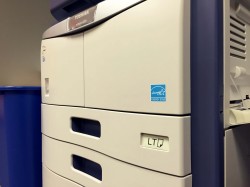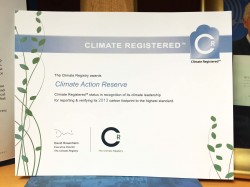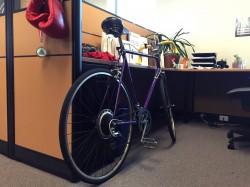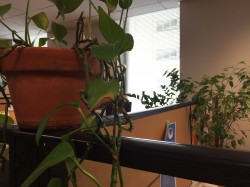A green office environment can boost employee health, morale, and productivity while supporting climate change solutions. We all know to limit our printing, recycle, buy eco-friendly office products, and enable Power-Save mode on our computers. But surely more can (and should) be done! Here are some creative ideas to green your (already green) office. We’d love to hear your ideas too! Please share in the comment section below.
| Creative outside the box ideas to green an (already green) office |
| 1. Rethink office lighting: Ditch the officewide florescent lights and just use natural light + decentralized desk and floor lamps. Consider “day lighting” retrofits, such as daylight redirection and fiber optics, lowering partitions, and rethinking indoor shading. |
2. Find every way to save energy: Use laptops rather than desktops which helps save energy, use energy-star electronics in energy save mode, encourage staff to bring snuggies rather than turn up the heat, use lights on motion detectors. Use laptops rather than desktops which helps save energy, use energy-star electronics in energy save mode, encourage staff to bring snuggies rather than turn up the heat, use lights on motion detectors. |
| 3. Solar charger for cell phones: Considering how we all have cell phones and often need to charge them in the office, consider investing in an office solar charger that staff members can use to charge phones or other small electronics. Or consider a bicycle-powered charger, if you don’t mind getting a little exercise. |
| 4. Prize vault: In an effort to reuse items and prevent waste, create an office prize vault where staff can donate items such white elephant gifts they’d never use or gently used items that are no longer wanted. At the Reserve, we also throw in the cool swag that staff picks up at conferences or received as gifts from vendors and clients (which we’re not allowed to keep personally per our conflict of interest policy). The prize vault helps prevent items from going to waste and can be used to incentivize green actions. |
| 5. Casual dress: Not wearing suits means much less dry cleaning, which is better for the environment, health, and finances. |
| 6. Sustainable, used purchases: Use reusable, recycled, FSC certified, fair trade, and biodegradable products when available. In addition, consider used furniture before buying new. (There is a glut of used office furniture out there!) |
7. Reduce waste: I’m sure we all only print when necessary and only print double sided when we do. Remember to use projectors during meetings instead of printing agendas, bring laptops to meetings for notes or to refer to files, reuse blank back sheets, use a paperless fax, and continue using electronics until end of life. Also, be sure to recycle e-waste and batteries. Encourage recycling by making sure all staff has a recycle bin at their desk. And keep the office kitchen stocked with glassware instead of bottled water and ‘real’ coffee mugs instead of paper. Buy sugar, milk etc. in bulk instead of single use packages. I’m sure we all only print when necessary and only print double sided when we do. Remember to use projectors during meetings instead of printing agendas, bring laptops to meetings for notes or to refer to files, reuse blank back sheets, use a paperless fax, and continue using electronics until end of life. Also, be sure to recycle e-waste and batteries. Encourage recycling by making sure all staff has a recycle bin at their desk. And keep the office kitchen stocked with glassware instead of bottled water and ‘real’ coffee mugs instead of paper. Buy sugar, milk etc. in bulk instead of single use packages. |
| 8. Rearrange trash bins: Consider removing trash cans from cubicles and offices, only retaining a recycling bin, forcing individuals to walk to a communal trash can for non-recyclable items. We’ve heard of successful organizations doing this, and people grumbled at first, but it did force people to think more about their waste, causing an increase in recycling and decrease in trash! |
| 9. Tupperware for lunch outings: Bring your own or have an office stash of Tupperware available to take to lunch if you think you will have leftovers. |
10. Measure, report, and verify your carbon footprint: The Reserve is a Member of The Climate Registry, and we use their software to measure, report, and verify the greenhouse gas emissions associated with our organization’s activities. The first step to reducing emissions is accurately measuring your emissions. Your emissions profile will help you identify inefficiencies and pursue appropriate actions to reduce emissions. The Reserve is a Member of The Climate Registry, and we use their software to measure, report, and verify the greenhouse gas emissions associated with our organization’s activities. The first step to reducing emissions is accurately measuring your emissions. Your emissions profile will help you identify inefficiencies and pursue appropriate actions to reduce emissions. |
| 11. Then offset your carbon footprint: We are a carbon offset registry! Of course we’re going to offset our own emissions. We created a Blind Trust to offset our Scope 1, 2, and 3 company emissions without a conflict of interest. |
12. Green that commute! Or get rid of it altogether! Subsidize public transit cards to promote transit ridership and reduce employee stress – I can’t imagine how grumpy I’d be if I had to drive in LA traffic every morning. Consider an office telecommute policy, which would allow for reductions in both greenhouse gas emissions and commute time. Here at the Reserve, staff may work from home up to 2.5 days per week. Also, consider developing an incentive program for replacing car commutes with bicycle commutes. For example, for every 10 car rides replaced with bicycle, the staff member could pick a prize from the office prize vault. Due to some staff working remotely or some commutes being impossible by bike, you could expand the program to any 10 car rides replaced, including errands on the weekend. (That is, if you trust your coworkers enough to use an honor system!) Subsidize public transit cards to promote transit ridership and reduce employee stress – I can’t imagine how grumpy I’d be if I had to drive in LA traffic every morning. Consider an office telecommute policy, which would allow for reductions in both greenhouse gas emissions and commute time. Here at the Reserve, staff may work from home up to 2.5 days per week. Also, consider developing an incentive program for replacing car commutes with bicycle commutes. For example, for every 10 car rides replaced with bicycle, the staff member could pick a prize from the office prize vault. Due to some staff working remotely or some commutes being impossible by bike, you could expand the program to any 10 car rides replaced, including errands on the weekend. (That is, if you trust your coworkers enough to use an honor system!) |
| 13. Green meetings and webinars: Rather than in-person meetings which require travel, have telephone meetings and online webinars as much as possible. |
14. Indoor plants: We work in a veritable urban forest with an average of 2 plants per employee workspace. Plants can be chosen specifically based on ability to improve local air quality: http://www.mnn.com/health/healthy-spaces/photos/15-houseplants-for-improving-indoor-air-quality/a-breath-of-fresh-air We work in a veritable urban forest with an average of 2 plants per employee workspace. Plants can be chosen specifically based on ability to improve local air quality: http://www.mnn.com/health/healthy-spaces/photos/15-houseplants-for-improving-indoor-air-quality/a-breath-of-fresh-air |
| 15. Form a sustainability committee: Join fellow coworkers to brainstorm and research new sustainability initiatives for the workplace, find cool local green events that may interest staff, and coordinate eco volunteer events for staff to give back to the community. |
Further reading:
http://www.nature.org/greenliving/gogreen/everydayenvironmentalist/green-your-office.xml
http://www.treehugger.com/htgg/how-to-go-green-at-work.html
http://www.davidsuzuki.org/what-you-can-do/green-your-workplace/




